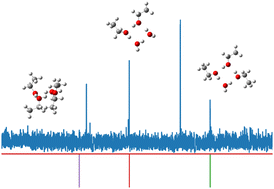Chirped pulse Fourier-transform microwave spectroscopy of alcohol and water tetramers†
Abstract
In an effort to build towards quantitative models of alcohol:water microaggregation in liquid mixtures, the present works characterizes the energy landscape and structures of pure ethanol and mixed ethanol:water tetramers using Chirped Pulse Fourier-transform Microwave spectroscopy. Many conformers of each type of tetramer are available, and those with sufficiently strong dipole moments are experimentally examined. This analysis considers, but does not explicitly fit, the splitting of rotational states due to internal rotation of the methyl groups present, as well as utilizes isotopic substitution experiments to verify the conformer variations observed. Implications of the listed results include a suggestion of the stability of micro-aggregated structures as opposed to homogeneously mixed clusters, informing future work on characterization of larger clusters and any potential modeling of the hydrogen bond network at play.



 Please wait while we load your content...
Please wait while we load your content...
